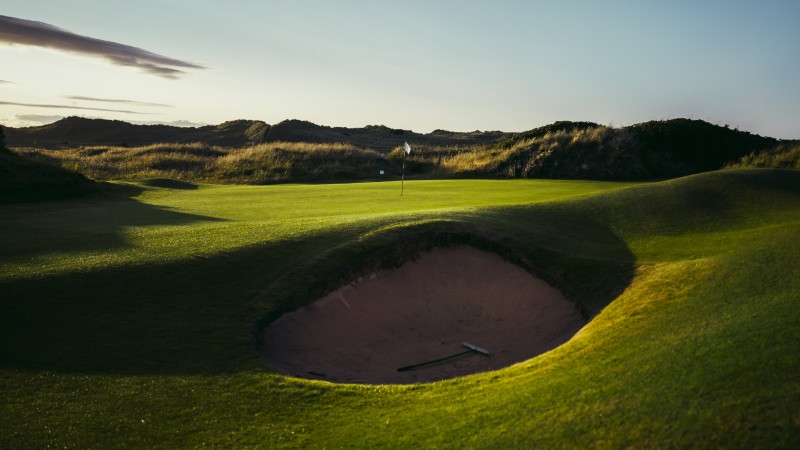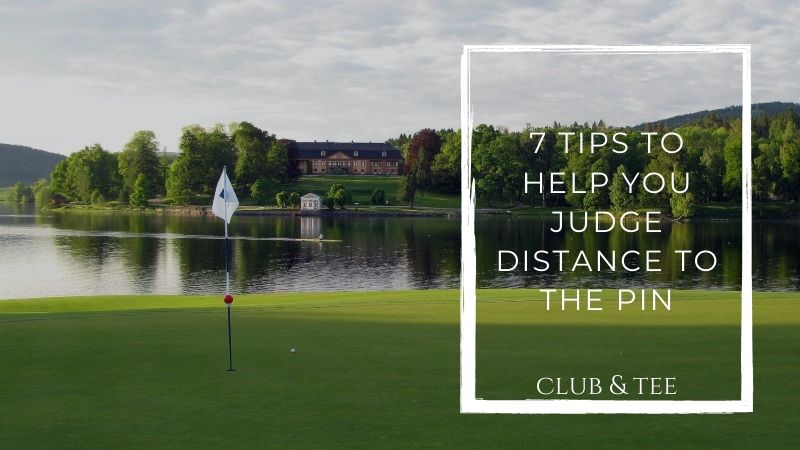The best way to lower your scores on the golf course is to hit more greens in regulation. The more birdie putts you can have in 18 holes, the better. This means your approach game needs to be precise. It does not matter if you hit the shot perfectly if you chose the wrong club. The analysis and decisions you make prior to starting your swing have a huge impact on your score.
With that in mind, how can you better judge the exact distance to the pin and pick the correct club for every approach shot? What factors should you consider when making club selection? You most likely do not have a caddie when you play, but you need to learn to think like one.
Here are 7 tips on how to measure golf shot distance to the flag and pick the correct club every time! We recommend that you progress through these items prior to each approach shot.
You may also like:
1. Use Modern Technology
If possible, leverage a Rangefinders or GPS device to determine the exact yardage between your golf ball and the flag. These GPS devices that have various models and features will not only give you accurate distances, but you also have the benefit to speed up your pace of play. It is much quicker to “shoot” the flag with your rangefinder than it is with walk-off yardages.
Another advantage of using a golf distance measuring device is that you naturally learn how far you hit each club. On the course or the driving range, you will quickly understand that your 8-iron goes 145 yards versus your 7-iron, which travels 155.
If can not afford one of these tools or simply like doing it the old-fashioned way, that is fine. Your first step when you reach your ball should be to measure this number by walking off the different distances between you and the nearest marker. You can not pick a club until you know your yardage to the pin.

2. Course Markings
When you play the 1st hole, make sure you know how the course is marked. Do they only have a 150-yard stake or are there markers in the fairway for 100, 150, 200, and 250 yards?
If you do not have a rangefinder, you will use these to step off your distance. For most players, a stride equals one yard. For example, if you see the 150-yard stake in front of your ball, count how many strides it takes to reach it and add that number to 150. 12 strides to reach the 150-yard stake and you need to hit a 162-yard shot.
Even if you are using a rangefinder, you need to be aware of the course markings to avoid making a mistake. When you are attempting to “shoot” the pin with your rangefinder, it is quite easy to accidentally determine distance to a hill or a tree behind the green.
By understanding the course markings, you can quickly double-check that the number you are seeing on your distance-measuring device is accurate. For example, if you are near the 150-yard marker, but your rangefinder tells you 210 yards – something is probably wrong.
3. Pin Placement – Front, Middle, or Back
It is critical to consider pin placement before picking your club. There are several different ways a course might tell you the location of the pin. Many use different color flags to represent the location and others have a grid on the scorecard.
If you already know your yardage, why is it important for you to know the location of the pin on the green? You do not want to go long to a back pin, and you do not want to come up short to a front one. The goal is to leave yourself the best possible putt for birdie. When in doubt, always play to the middle of the green, regardless of the hole location.
4. Slope
Next, is your shot uphill or downhill? By how much? This can change the club you hit by as many as 2 full clubs because the elevation changes. It will take some practice but try to think about the slope in terms of how many clubs it is going to impact the target. In other words, one-shot might be ½ of a club downhill or a full club uphill.
You also need to consider how the slope will impact the green. If you are hitting uphill to the green, your ball will come in at a lower angle and spin less. This could play a role in the club you select or the type of shot you hit.

5. Wind
Depending on your golf course settings, wind can be a significant factor when you are trying to determine your distance and the correct club to swing. Similar to slope, think about it in terms of clubs.
How many clubs do you need because of the current wind conditions? The best way to test the direction of the wind is to simply toss some grass in the air or see which way the flag is blowing. The swirling wind can be a player’s worst nightmare when trying to pick the correct club.
Again, you need to consider how the wind will impact your shot when it lands. If you are hitting the wind, your ball will spin more. Downwind your ball is more likely to release and roll out.
6. When in Doubt, Hit Extra Club
What is the most common miss amongst amateur golfers? They come up short of the green. This can be because they did not properly calculate distance, or they mishit the shot. If you progress through our first 5 tips and are stuck between two clubs, we always recommend hitting the longer club.
Unless you hit every shot perfectly, this will allow for a bit of an off-center strike. There is nothing wrong with a slight mishit that still ends up on the green.
7. Identify Danger – Do Not Short-side Yourself
The final tip and the final step before you hit the shot – where do you want to avoid? Is there a deep bunker you want no part of? Is there a water hazard left in the green or deep woods just over?
Golf is all about being able to play your misses. How do low handicappers save strokes? They typically miss shots in the correct spot. So, before you pick your club and pull the trigger, make sure the decision gives you the best chance for par, even if you miss the green.
You can aim for some great scores if you always hit the middle of the green or miss the green on the correct side. Also known as the safe side.
Added Tip:
Keep Records
The longest potential distance you have ever hit a club is not the same as the average distance you have ever hit that club. Thinking they are the same will only hinder your ability to manage the course and achieve good scores. It’s vital to keep accurate records on your shots and their distances, regardless of the technique you use. If you’re using a launch monitor, you should be able to acquire a printout of each shot you hit.
FAQs
How do you judge distance without vision?
While vision is a significant source of data, it is not the only source of distance measurement. The blind golfer’s strategy is to pace off each putt. The amount of paces between the ball and the hole determines how hard to stroke the ball.
How do you judge a distance to a pin in golf?
Subtract the distance between the flagstick and the hole’s total yardage. If the hole is 380 yards from the tees you used and the rangefinder says you’re 120 yards from the flag, you hit your drive 260 yards.
How do I get more distance on my golf clubs?
Make practice swings more difficult. Moving the club faster is an excellent technique to gain distance. When the club moves faster, the chance of gaining more distance increases. Simply begin by raising your practice swings off the ground with confidence.
How can I increase my swing distance without swinging faster?
You can improve distance without swinging quicker simply by optimizing your impact. The Fix: Learning what impact looks and feels like is one of my training exercises. Get into your set up with a 7 iron. Return to your impact position without taking the club back.
Why do all my golf shots go the same distance?
The first consideration is speed. It will appear that all of your clubs fly the same if you don’t have enough club head speed or if your club head is decelerating. Even shorter clubs can sometimes fly further when this is the case.
Final Thoughts on Judging the Distance to the Pin
Wow – this is a lot of information to process prior to each shot. Are you worried you will not develop to play golf round in under 6 hours? Do not worry – generally, once you get used to considering these factors, you can run through these pre-shot tips in 5-15 seconds, own your golf game gain your experience. The most critical parts of your next shot are the decisions you make prior to even taking the club back!
Improve your ability to assess distance and select the right club – enjoy shooting lower scores.

